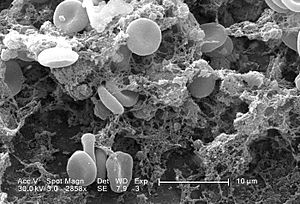Cell biology facts for kids
Cell biology is the study of how living cells work. It looks at what cells are made of (their structure) and what they do (their function). This includes the tiny parts inside cells called organelles, and the carbon-based molecules cells create.
Cell biology uses ideas from many other science areas. These include genetics (the study of genes), biochemistry (the chemistry of life), molecular biology (the study of molecules in cells), and immunology (the study of the immune system).
The most important molecules in cell biology are DNA, RNA, and proteins. The main structures inside a cell are the nucleus and chromosomes, but there are many others.
There are two main types of cells: eukaryotic and prokaryotic. Eukaryotic cells are much more complex. They have special compartments called organelles. Scientists believe some organelles, like mitochondria and plastids, used to be simple prokaryotic cells themselves. This idea is called endosymbiosis.
A very important job of cells is to divide. Cells divide either by mitosis or meiosis. In a multicellular organism (like you!), cells also become special for different jobs. This means different cell types can look very different from each other.
- Cytology is a part of cell biology that mainly focuses on what cells look like and how they are built.
What Can You Do with Cell Biology?
Studying cell biology can lead to many interesting jobs. Here are some examples:
|
|
|
Images for kids
-
Czech anatomist Jan Evangelista Purkyně is known for discovering Purkinje cells in 1837.
-
Theodor Schwann discovered the Schwann cell.
-
Yoshinori Ohsumi won a Nobel Prize for his work on autophagy.
See also
 In Spanish: Biología celular para niños
In Spanish: Biología celular para niños






